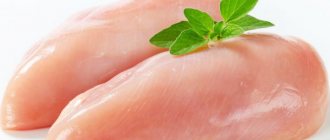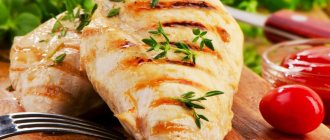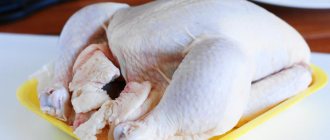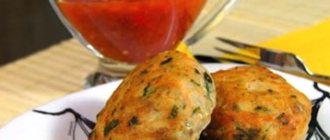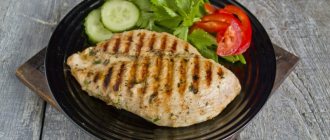Contraindications
Baked chicken breast
Any diet for weight loss, including those based on chicken meat, is intended for healthy people who do not have chronic diseases. The chicken diet is characterized by an abundance of proteins, which negatively affect kidney health. If you have any problems with the urinary system, avoid this diet. With long-term adherence to such a diet, there is a pronounced lack of fat, which leads to metabolic disorders. Problems also arise for those losing weight who at the same time give up salt - this can lead to increased bone fragility. An excess of protein does not have a very good effect on the gastrointestinal tract, which can cause an increase in acidity, impaired peristalsis and constipation. Some people who are losing weight note increased brittleness of their nails and deterioration of their skin and hair.
Don't lose weight on the chicken diet if you:
- are pregnant or breastfeeding;
- have a chronic disease;
- under 18 years of age or over 55;
- have problems with heart health, gastrointestinal tract;
- recovering from a serious illness or surgery.
If you are unsure whether this diet is right for you, consult your doctor. This way you will avoid possible complications and not subject your body to undue stress. Be especially careful when choosing a mono-diet - it is better to dilute the menu with a variety of vegetables, which will correct the side effects of high doses of protein.
The benefits of chicken fillet
Chicken breast in milk
Chicken breast is not only a valuable source of protein for our body, but also contains many different vitamins and minerals. Vitamins, in turn, take an active part in the processes of protein synthesis and other substances. Vitamins are essential for strength training; without them, it is impossible to effectively lose weight or increase muscle mass, regardless of the amount of protein consumed.
Chicken breast contains vitamins B, C, PP, A, as well as choline, a substance that ensures the proper functioning of organs, in particular the kidneys and adrenal glands, and cleanses the liver of excess fats and cholesterol. Potassium, which is contained in chicken fillet, acts as electrolytes in the body and helps maintain normal blood pressure. Chicken breast also contains equally important micro- and macroelements: sodium, magnesium, sulfur, iron, phosphorus and chlorine.
The nutritional value of chicken breast is great. This is a quite nutritious and healthy product, but the calorie content of chicken breast is balanced. 100 grams of fillet contain the most protein - 23.6 grams, there is little fat - 1.9 grams, and very few carbohydrates - up to 0.4 grams.
Boiled chicken breast is very useful for problems with the gastrointestinal tract, including gastritis and ulcers, it promotes digestion and neutralizes excess acidity in the body. White chicken meat is also useful for problems with blood vessels, it helps prevent heart attacks and strokes, and
The low calorie content of boiled chicken breast helps not to overload the body with extra calories. It is best to boil chicken in a saucepan, but the healthiest option is steamed chicken, which retains all the nutrients, has a beautiful appearance, and becomes very juicy and soft. Chicken breast is best consumed with vegetables to balance the simultaneous intake of protein and fiber in the body.
Chicken fillet is good for teeth, bone tissue and muscles; it contains the largest amount of zinc and phosphorus. Magnesium improves memory, restores nerve cells, relieves irritability, promotes wound healing, and B vitamins normalize blood sugar levels, which is why chicken breast is also recommended for elderly people.
Eating chicken breast has a positive effect on the body's metabolic processes, improves skin color, condition of nails and hair, and the selenium and lysine it contains have good antibacterial properties and strengthen the immune system, preventing colds.
Chicken harm
Many people refuse chicken precisely because it is loaded with preservatives and antibiotics. They negatively affect the body, as they cause a number of diseases. There are incredibly few nutrients left in the composition. Like any other product, chicken meat can cause allergic reactions. This is mainly due to the cooking method.
- Remember that smoked and fried chicken can contain a lot of cholesterol, which can clog blood vessels.
- If meat is not thoroughly cooked, there is a risk of becoming infected with bacteria that are dangerous to the human body.
- Avoid skins; if possible, remove them before cooking. This is a very fatty part of the meat, which means it contains a lot of cholesterol.
Nutritional value
The largest amount of white meat pulp is found in chicken breast. You can make many different dishes from it - tasty and easy to prepare. Together with chicken meat, our body receives the necessary nutrients, without which a full-fledged human existence is impossible.
- Most essential amino acids enter the body only with food, since the body is unable to reproduce them on its own. Doctors and nutritionists consider two amino acids out of the twelve that are contained in chicken meat to be especially valuable. The first is tryptophan, which is involved in the synthesis of the hormone serotonin, which is responsible for human wakefulness, as well as for calm and sound sleep. And the second essential amino acid is called lysine and is a building material for muscle tissue, as well as a strategic reserve of strength and energy for human life.
- Nine nonessential amino acids that are involved in all biological processes in the body. Particularly important among them is arginine, whose mission is to maintain the working condition of joints and help them recover from injuries.
- Unsaturated fatty acids that help the body rebuild and adapt to heavy physical activity.
- Polyunsaturated fatty acids Omega-3 and Omega-6, which are responsible for the condition of the skin, hair, nails, and have a beneficial effect on mental activity and performance.
- Omega-9 monounsaturated acid, which resists cancer and inflammatory processes.
- Vitamins of group A, B, C, PP, H, which play an important role in the proper functioning of the cardiovascular and digestive systems, are involved in water-salt metabolism, and strengthen the body’s immunity.
- Valuable minerals: iron, selenium, zinc, magnesium, copper, chlorine, sodium, phosphorus are important components in many biochemical reactions and physiological processes in the body. Without them, human growth and full development is impossible.
Cooking secrets
Turkey breast (calorie content depends on the cooking method) has a specific smell.
Therefore, to prepare juicy, tender and aromatic fillet, you must follow the following rules:
- when cooking the breast, add bay leaf and allspice to the broth;
- when baking, dill and garlic can improve the aroma;
- you can soak the breast in a sauce with spices or rub it with garlic;
- Before heat treatment, the fillet must be thoroughly washed and finally doused with boiling water, then the juices are retained inside;
- to reduce calorie content from the breast, it is necessary to remove the skin (its calorie content is about 100 kcal);
- when preparing the broth, the meat must be immersed in cold water; if the fillet will be used to prepare the second one, then it is immersed in boiling water;
- when frying, the breast must be basted with the released juice every 15-20 minutes, this will ensure the formation of a crispy crust;
- if the turkey carcass is frozen, then it needs to be thawed in the refrigerator for 24 hours;
- To preserve the juice, it is recommended to soak the fillet in salted water (400 g of salt per 4 liters of water) and leave for about 12 hours;
- Before frying, it is recommended to grease the breast with olive or butter and let it soak in. Bake at a temperature range of 160-170 °C.
It is important to boil, fry or stew the breast until it is completely cooked (can be determined by the juice that is released when you pierce the fillet with a knife, it becomes transparent), since the meat often contains pathogenic bacteria that die during heat treatment. The cooking process should be at least 30 minutes, frying at least 40 minutes
After the dish is ready, the meat should lie in the broth or in a frying pan under the lid for at least 15 minutes. This will add juiciness and softness to the meat.
Tested on chickens
We continue our “economical” section.
This time we asked ourselves which chicken fillet is cheaper and by how much. For the experiments, we took 1 chicken and 1 chicken breast.
The cost of chicken fillet in different stores varies greatly. We chose a chain store, where, as it seemed to us, the price for fillet was very affordable - 229.90 rubles. for 1 kg.
On the next shelf there was chicken fillet from the Reftinskaya poultry farm and it was already much more expensive - 337.90 rubles per 1 kg.
The weight of the clean fillet was 80% of the weight of the breast. Thus, the cost of our fillet is 187.38 rubles per 1 kg.
Next we took on the chicken, from which we also cut fillets. The cost of a broiler chicken carcass for 1 kg is 115.90 rubles.
The weight of the chicken fillet weighing 1.722 g was 438 g.
Thus, the cost of chicken fillet from a whole carcass is 455.5 rubles. for 1 kg. It’s definitely not worth buying a whole chicken just for one fillet.
Since we bought a chicken, we decided to make homemade chicken ham from it, and then determine the cost of this homemade chicken ham. After visiting our friendly site Yu-mama, we found a great recipe.
From our chicken weighing 1.722 kg and costing 199.58 rubles. we prepared exactly 750 g of homemade ham.
The cost of homemade chicken ham was approximately 266 rubles. for 1 kg. For comparison: the cost of a chicken roll from the Reftinskaya poultry farm is about 400 rubles. for 1 kg.
1. If you decide to cook chicken fillet, then don’t be lazy and buy chicken breast. It's more profitable. It will take you no more than 5 minutes to turn the breast into fillet, and you can cook soup from the bone.
2. Preparing the chicken for the chicken wrap will take about 15 minutes. But it's worth it!
source
Compound
How many calories are in candied pineapples and other fruits per 100 grams? Is it possible to lose weight?
In addition to the relatively low calorie content of chicken breast, a positive property of the product is the large amount of proteins in its composition. This is the most useful part of the chicken carcass. Chicken breast fillet has a unique composition:
- sulfur;
- chromium;
- magnesium;
- cobalt;
- phosphorus and other trace elements.
In addition, boiled chicken breast contains vitamins of groups B, C, PP, A, E and others.
On a note! Brisket fillet contains 4 times less fat than leg meat of the same chicken.
Boiled chicken breast is beneficial for the human body. It enriches it with the necessary protein without loading it with extra calories, harmful cholesterol and fat. And the protein contained in the fillet is perfectly digestible. If you cook chicken correctly, it will turn out not only low-calorie and healthy, but also very tasty. There are a huge number of dishes that contain chicken breast, so the menu will not be monotonous.
That is why it is difficult to overestimate the role of vitamins in various diets. Chicken breast meat contains almost all known vitamins of groups A, B, C and PP. Chicken meat is also an excellent source of choline, which has a good effect on the liver and kidneys, clearing them of fats and promoting normal functioning.
Another important micronutrient that chicken breast can boast of is potassium. Probably everyone has heard about its beneficial properties from television advertisements. Potassium normalizes blood pressure, carrying out the function of electrolytes in the blood, and promotes the transmission of nerve impulses. Along with the vitamins listed above, the “bird product” includes iron, magnesium, phosphorus, sulfur, sodium, chlorine and many other micro- and macroelements that are so necessary for the proper course of life.
Chicken fillet is a champion in terms of easily digestible protein content. Its low fat content makes it ideal for the daily diet of athletes who want to build muscle without fat.
Contains vitamins B6, B12, PP, A, C, H. Mineral components include potassium, zinc, copper, magnesium, selenium, manganese, chlorine, cobalt, iron, sodium, phosphorus, sulfur. Thanks to this mineral composition, with regular consumption of white meat, you can maintain normal functioning of the cardiovascular system, fill the body with strength, and make it easier to endure the consequences of operations and other diseases. Probably many people know that it is very useful for any sick person to drink broth from skinless chicken breast.
Adherents of proper nutrition and a healthy lifestyle know firsthand the need to include lean meat in their daily diet. PP supporters give preference to poultry meat. This is not surprising, because it is the lowest in calories and dietary, and, therefore, the likelihood that this product will harm the body or figure is minimized. The most useful part of a chicken is considered to be its sirloin, or more precisely, its breast.
Chicken breast meat is very specific. This part is often called white meat. Indeed, this part, when compared with the rest of the chicken, is the lightest. It is worth noting that not everyone likes boiled chicken breast, despite all the beneficial substances it contains. The fact is that such meat tastes quite dry, and if you overcook it, it will become tough and difficult to chew. It is worth noting that the fat content in chicken breast is 4 times lower than in the ham or drumstick of the same chicken.
Boiled chicken is simply a storehouse of nutrients: vitamins and minerals. It contains a huge amount of protein, which is easily absorbed by the body, and very few carbohydrates and fats. Therefore, chicken is often preferred by those who want to get their figure in shape. As for the ratio of BJU in the chicken breast itself, 100 g contains:
- protein – 30 g;
- fat – 2 g;
- carbohydrates – 0.5 g.
This is a partial list of all the nutrients that make up chicken breast. The product is suitable for a variety of consumers: from kids to dry athletes. The broth in which the breast was cooked is recommended for patients with problems with the gastrointestinal tract as a first course for lunch.
How to choose a chicken
Not everyone knows how to choose the right chicken. But if you don’t want to eat low-quality dishes or, even worse, end up poisoning your dinner, then the following tips will help you with choosing a product:
When purchasing, pay attention to what the chicken looks like. You need to choose one whose limbs are more or less proportional to the body
Otherwise, it grew thanks to harmful substances that were injected into the carcass. You can touch it: the right chickens have a springy, non-rigid breast. The chicken cannot have visible defects: fractures, scratches, etc. The color of the carcass should be pale pink. If there is a dark yellow bird in front of you, then it is an adult chicken. It's better to take a young one. Try applying light pressure to the bird. If a dent remains, then it is better not to take this carcass. A proper chicken should immediately return to its previous shape. Of course, it's worth smelling the meat. After all, it is by smell that we usually determine the freshness of all products, even if we do not know how to choose them correctly. Chicken is not fresh if its skin is sticky. This is a sign that hormones were injected into her. The skin should be dry and non-slip. It is best to buy chilled meat, not frozen, as after defrosting the chicken will be very tough. The only situation where you can use frozen meat is if you need to stock up on food for a week or a month. We study the packaging: it must have a mark of inspection by the State Veterinary Supervision Authority and the presence of GOST. Moreover, it must indicate the shelf life and the name of the poultry farm. Choose chicken in transparent packaging so you can see it all. You shouldn't have any surprises at home. It is preferable to take packages without damage. If you are going to make soup, choose an older chicken to ensure a rich broth. It is best, of course, to take poultry. For all other recipes where chicken is fried, stewed or baked, you need to take a carcass that weighs just over a kilogram.
Chicken dishes are healthy foods that provide the body with many nutrients and energy. Try reviewing your diet and adding more chicken to it.
We hope you find these tips helpful. Choose your product carefully, not forgetting our recommendations, to truly enjoy your chicken dish.
And a little about secrets.
Chicken breast in the oven
The story of one of our readers Alina R.:
I was especially depressed about my weight. I gained a lot, after pregnancy I weighed as much as 3 sumo wrestlers together, namely 92 kg with a height of 165. I thought the belly would go away after giving birth, but no, on the contrary, I began to gain weight. How to cope with hormonal changes and obesity? But nothing disfigures or makes a person look younger than his figure. At the age of 20, I first learned that plump girls are called “WOMAN” and that “they don’t make clothes that size.” Then at the age of 29, divorce from my husband and depression.
But what can you do to lose weight? Laser liposuction surgery? I found out - no less than 5 thousand dollars. Hardware procedures - LPG massage, cavitation, RF lifting, myostimulation? A little more affordable - the course costs from 80 thousand rubles with a nutritionist consultant. You can, of course, try to run on a treadmill until you go crazy.
And when will you find time for all this? And it's still very expensive. Especially now. Therefore, I chose a different method for myself.
Why is white chicken meat so beneficial and who should take it? Calorie content, protein, carbohydrates and fat content in it.
For an athlete, one of the main criteria for success is proper nutrition.
It is important to include in your diet foods that avoid saturation with fats and fast carbohydrates, but at the same time provide a sufficient amount of protein. Chicken breast is an ideal option, containing a minimal amount of fat, and the amount of protein is sufficient to cover most of the muscle building material needs
This product is great for people who are looking to gain lean muscle mass, lose weight, or maintain weight.
But how much protein is in chicken breast? What benefits does it have for the body?
Weight
To prepare some dishes, it may be necessary to know the exact weight of one poultry breast. This indicator depends on several factors. The main ones are:
- chicken breed;
- her age;
- conditions of detention and habitat.
It is quite natural that chickens of meat breeds, birds that are more mature or raised in private farmsteads will have a larger breast. Small breeds of chickens, young birds, or birds raised in large poultry farms will have less voluminous breasts.
For this reason, you can find these products weighing from 500 to 900 grams on the shelves. Based on these data, we calculate the average weight of 1 piece. breasts. Let's add up the mass of the largest and smallest breasts, and divide the resulting result in half.
The average weight of one chicken will be 700 grams.
- The weight of fillet with skin, carefully separated from bones and joints, is approximately 500 grams.
- The weight of the poultry flesh without skin and bones is 450 grams. Half a fillet weighs 225 grams.
- The weight of fillet in 100 grams of such a breast is (450/700) x 100 = 64 grams.
- Weight of fillet from 200 grams of breast 64x2 = 128 grams.
- Chicken skin can be denser with a larger layer of subcutaneous fat.
- The pulp from the seed itself can be separated more or less carefully.
Calculations for each breast, even with the same weight, may differ. But using them, if the need arises, you can prepare tasty and healthy food from its fillet.
You will learn more about the properties of chicken breasts by watching the following video.
Boiled chicken fillet is the main product of most low-carb diets, as it contains a minimum of calories. Unlike chicken drumsticks, wings and thighs, breast contains less fat and tastes almost the same. It is chicken fillet that is popular in the diet of most athletes, as it contains a large amount of animal protein and vitamins and minerals necessary for the functioning of the body.
IT IS IMPORTANT TO KNOW! Fortune teller Baba Nina:
“There will always be plenty of money if you put it under your pillow...” Read more >>
In kefir with spices
Chicken breast can be cooked in kefir with spices in a frying pan.
List of required ingredients:
- chicken breast – 2 pcs.;
- kefir – 1/3 tbsp.;
- freshly ground pepper;
- table salt;
- provencal herbs.
Chicken breast: BJU per 100 grams
Main stages of preparation:
- First you need to wash the chicken breasts, dry them using a paper towel, and cut them into oblong pieces. Afterwards, add Provençal herbs, freshly ground pepper, table salt into a deep bowl and mix well.
- Then you will need to sprinkle the fillet pieces with a mixture of spices, pour in kefir, mix thoroughly and leave for 2 hours to marinate the meat.
- Next, drain the kefir from the meat, transfer the meat to a preheated frying pan and fry for 10 minutes. Then you need to reduce the heat and bring the meat until cooked.
You can add onions, tomatoes, water, carrots, champignons, butter, lemon, bell pepper, herbs, buckwheat, zucchini, eggplant, and spinach to the chicken. Kefir is replaced with sour cream or milk. The dish is served in portioned plates, garnished with chopped herbs and fresh vegetables, with boiled rice, mashed potatoes or noodles.
How much protein is in chicken breast per 100 grams: healthy recipes, table of fats and carbohydrates
Protein is the building block of the human body. Thanks to amino acids, muscles grow and energy and hormonal metabolism occurs.
For a productive life, the body needs more than 30 amino acids. 22 of them are replaceable; the body synthesizes them on its own. Essential amino acids are not produced in the body, so they must be obtained from food. Meat, fish and dairy foods are the main suppliers of protein.
The most dietary product is white meat. When compiling a diet, you need to calculate how much protein is in the chicken breast and other parts of the carcass.
proteins, fats and carbohydrates in chicken breast per 100 grams
When calculating the diet, energy value and macronutrient composition are taken into account.
A person’s need for amino acids depends on:
- gender;
- age;
- health conditions;
- level and frequency of physical activity.
The uniqueness of white fillet lies in its balanced BJU and chemical composition.
Low lipid content, almost complete absence of carbohydrates, low calorie content and a record percentage of essential amino acids allow breast meat to be used in nutrition for various purposes, be it muscle growth or a fat-burning diet.
To calculate daily consumption, weigh the portions, determine the body's needs based on the quantitative composition of nutrients and the balance of macronutrients per 100 g of breast:
- the energy value of a steamed dish is 114 kcal;
- proteins – 24 g;
- fats – 2 g;
- carbohydrates – 0.1 g.
The average daily protein requirement can be met by consuming 80 g of pure protein. 300 g of meat will completely cover the needs of the human body with average activity.
Athletes and people involved in heavy physical labor should calculate the norm individually, depending on the level of stress.
Calorie content and nutritional value of chicken breast with skin
The main amount of fat in poultry is located under the skin. Nutritionists recommend eating cleaned fillets to reduce the intake of cholesterol contained in animal products into the blood and not exceed the daily energy requirement.
Compare the macronutrients and calories in skin-on chicken breast:
- The energy value of boiled fillet with skin is 147 kcal.
- proteins – 22.4 g;
- fats – 3.6 g
- carbohydrates – 0.2 g
With a slight decrease in proteins, the fat content almost doubled compared to skinless meat.
The main amount of fat in poultry is located under the skin
Taking into account the norm of fat consumption (1 g per 1 kg of weight for a person with a normal body mass index and weight 60 kg), 300 g of fillet with skin will cover only 1/6 of the lipid norm.
Bzhu in raw, boiled, smoked and fried chicken breast
Long-term nutrition programs or constant adherence to the principles of proper nutrition imply creating a menu of healthy and varied dishes. If you are tired of boiled chicken, you can fry or bake this product.
The calorie content and balance of BZHU will change, take this fact into account when selecting your diet.
| Method of preparation/KBJU | Raw | Boiled | Smoked | Fried |
| Calories, kcal | 137 | 113 | 117 | 162 |
| Amino acids, g | 24 | 28 | 18 | 25 |
| Lipids, g | 2 | 1.8 | 5 | 8 |
| Carbohydrates. G | 0.4 | 0.5 | 0.1 | 1.3 |
Raw meat contains more water, and when boiling and other cooking methods, the liquid evaporates, so the macronutrient content of cooked meals differs from raw meat.
To introduce carbohydrates and fiber into your diet, you can add vegetables to the steamer where the fillet is cooked 5 minutes before the meat is ready.
Bju in other parts of the chicken
To diversify the menu, you need to include all parts of the bird in your nutrition program. The thigh and drumstick contain more fat, which means their nutritional value is higher.
Chicken drumstick
Less caloric than thigh due to the large number of muscle fibers. A leg baked in the oven has the following KBJU indicators - 174/20/10/0.7 g per 100 g.
Chicken calorie content, beneficial properties
Calorie content of individual chicken parts
Chicken carcass parts are not uniform in calorie content. In ascending order, the caloric content of individual parts is as follows:
- calorie content of chicken breast (fillet) – 115 kcal per 100g;
- calorie content of chicken legs – 1 60–190 kcal per 100g;
- calorie content of chicken thigh – 1 80–210 kcal per 100g;
- calorie content of chicken wings – 1 80–190 kcal per 100g.
Calorie content of chicken by-products:
- calorie content of chicken stomachs – 100–130 kcal per 100g;
- calorie content of chicken liver – 140 kcal per 100g;
- calorie content of chicken hearts – 1 50–160 kcal per 100g.
Weight of individual chicken parts
To make it easier to count calories in servings, the average weight of individual parts of a chicken carcass is given below:
| part of a chicken carcass | average weight in grams |
| chicken breast (half) | 200g |
| chicken leg | 300g |
| chicken wing | 1 00–150 g |
| chicken thigh | 100g |
Dependence of calorie content on cooking method
The cooking method naturally affects the calorie content of the dish.
- calorie content of boiled chicken – 200–220 kcal per 100g;
- calorie content of stewed chicken – 200–230 kcal per 100g;
- calorie content of fried chicken – 240 kcal per 100g;
- calorie content of smoked chicken – 210 kcal per 100g;
- calorie content of grilled chicken – 2 10–260 kcal per 100g.
How to reduce the calorie content of chicken meat
- The largest amount of fat is contained in chicken skin, before cooking, remove the skin from the chicken and remove all fat;
- regarding chicken broths and soups - cook dishes in the second broth, after boiling, drain the water, pour in new water and cook until done;
- choose the right cooking method - boiled and baked chicken in foil are considered the most dietary products;
- cook it yourself - when buying ready-made grilled chicken, you cannot exclude the use of additional additives, sauces, fats, which significantly increase the calorie content of the chicken;
- It is recommended to serve chicken meat with herbs and vegetables; the fiber they contain promotes the rapid absorption of fats;
source
Turkey (breast)
Turkey meat is considered a dietary product due to its large amount of easily digestible protein. The most dietary part of any bird carcass is the breast; in turkey, the breast muscle contains virtually no fat, so the meat has a uniform structure and a pale pink color. The weight of a turkey breast is greater than that of a chicken breast; the breast of one bird is quite enough to prepare a light, nutritious and healthy dish for 4 people.
Composition and beneficial properties of turkey breast
Turkey breast meat is rich in complete protein and contains amino acids, including tryptophan, which is a precursor of melatonin, and arginic acid. B vitamins, which are necessary for the normal functioning of the nervous system, are present in the product in almost complete composition. Turkey breast contains a minimal amount of fat, so consuming the product does not increase cholesterol levels. Selenium, found in turkey in sufficient quantities (a serving of boiled breast contains half the daily requirement of the element), is necessary to maintain normal hormonal levels. Turkey meat is also useful for disorders of the gastrointestinal tract, as it normalizes metabolic processes.
Turkey harm
It is not recommended for those who suffer from gout and kidney failure to get carried away with eating turkey meat; excess protein can cause more harm than good.
Turkey in weight loss
Dietary turkey breast meat is traditionally included in the menu of diets and nutrition systems for those who are trying to lose weight without losing muscle mass (calorizator). For example, the grandmother's diet, the 800-calorie diet, or a fasting day on meat include turkey breast, boiled, steamed or grilled.
Selecting and storing turkey breast
When purchasing turkey meat, chilled or frozen, you need to pay attention to the integrity of the skin, the absence of dents and bruises. If the breast is without skin, the color of the meat should be light pink, the meat should be dense and uniform, not falling apart into fibers. When pressed, fresh turkey meat quickly regains its shape.
When pressed, fresh turkey meat quickly returns to shape.
Store refrigerated turkey breast meat purchased in packages in the refrigerator for 3 to 5 days, or according to the dates indicated on the package. Turkey breast purchased without packaging or after opening it should be cooked immediately and the leftovers frozen.
Turkey (breast) in cooking
Turkey breast is prepared in various ways, the meat is fried, baked, boiled, steamed and grilled. Cook the breast for a short time so as not to dry it out. Tender breast meat goes well with mushrooms and cheese; the almost neutral taste of the bird is easy to overpower with the strong aromas of spices and herbs, so the best additions to turkey breast are salt and black pepper. Turkey breast is used to prepare minced meat for cutlets, pasties and dumplings; boiled meat is used as a filling for pancakes, as an ingredient in sandwiches and salads.
When buying a turkey, everyone asks the question: “What tasty things can be made from turkey fillet?” So, you will find the answer to this question in our article “What to cook from turkey fillet.”


